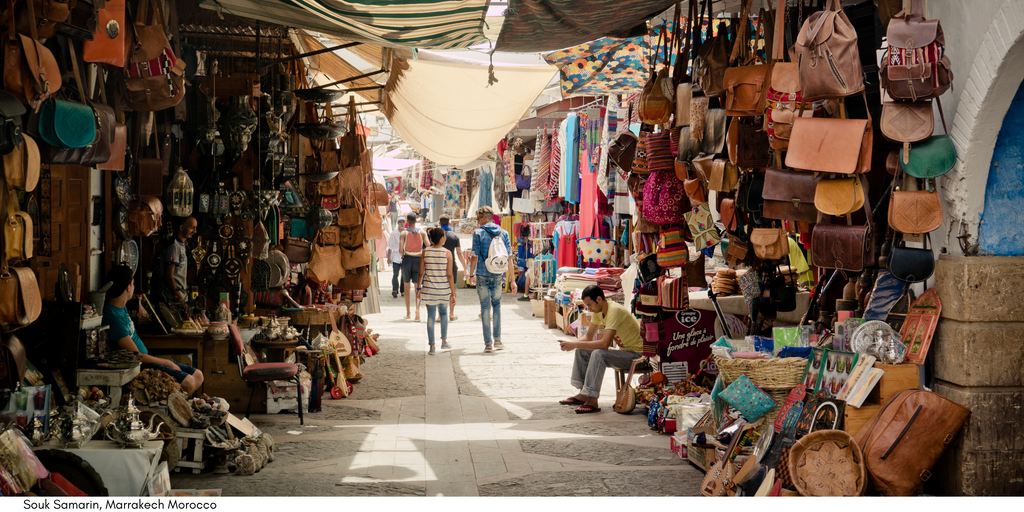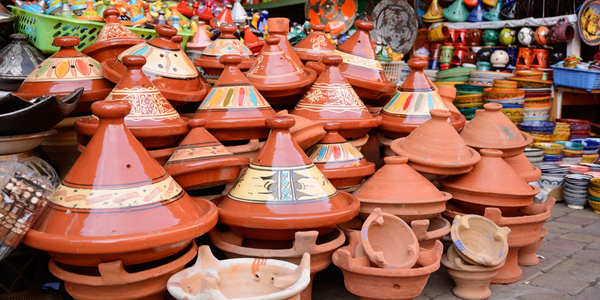
Morocco is a land rich in culture and traditions, and one of these is certainly craftsmanship. Today, production meets contemporary manufacturing methods, which allow for the transformation of a wide range of materials into highly decorative objects.
The history of Moroccan craftsmanship

Morocco's cultural richness also stems from traditional crafts, which have been around for several years in a more designer version. A variety of materials are finely crafted by hand, using largely traditional machines and tools, to create decorative and everyday objects. Whether it's tableware, furniture, jewelry, or clothing, you'll certainly be tempted to bring back some Moroccan souvenirs!
Marrakech, a city of a thousand faces, deserves to be discovered little by little, so as not to miss any of the secrets it hides. Above all, it is a country with a rich past and deeply rooted traditions.
Moroccan art can be divided into two categories: urban and rural. These are cities of art, rich in important traditions from the Orient or Muslim Spain. The Eastern influence is particularly focused on the creation of carpets, textiles, and embroidery, while the Andalusian tradition is still evident in the arts of ceramics, metal, wood, and leather.
Berber or rural art has a more ancient and "primitive" origin. The objects often have a utilitarian function: furniture, tools, utensils essential to daily life, and some Christmas and community decorations.
Craftsmanship in Marrakech is steeped in tradition. Each generation passes on their creativity to the next, and those who learn it use it to create true cultural industries. Marrakech's artisans are not only the custodians of their traditions, but also seek to enrich their cultural heritage and adapt to the demands of contemporary society. Indeed, Marrakech's craftsmanship is very rich and vibrant.
Wood, metal, copper, wool, stone, and clay have been used for centuries. Adapted to modern life, Marrakech's artisanal production, like its traditions, offers a wide range of products, from the art of filigree to the simplest everyday utensils.
Production city

Since the dawn of time, Marrakech has produced a wide range of products. In Fez and Marrakech, entire districts are reserved for tanners: bags , accessories, slippers , poufs , terracotta vases covered with leather straps, saddles.

The best products on the market
Moroccan rugs

In the Rabat, Fez , and Tetouan regions, a wide range of Moroccan crafts is available, including rugs that are in the spotlight in the medinas. Original and intricate patterns, sometimes in the center, sometimes on the edges, depending on their use, give rise to many reflections on their creations. In Morocco, the value of a rug is closely linked to the number of knots and the patterns that compose it, although it is important to distinguish between urban and rural rugs!
Traditional clothing

Traditional Moroccan clothing is still worn on special occasions and important ceremonies. It is being re-proposed on the market with a touch of innovation. Of course, to create a 100% Moroccan outfit, you can combine the traditional caftan with slippers . These are precisely the textile products that best represent Moroccan tradition, but which also adapt to new stylistic trends.
Try the famous caftan now! Babouches are also a symbol of typical Moroccan clothing. This fashion now comes in all styles, and many designers offer particularly stylish and contemporary models!
The Jewels

Looking to take home some original, handmade jewelry ? Marrakech and its surrounding areas are full of sumptuous Amazigh jewelry! You'll find it in the medina, near Jemaa El Fna Square. Many silver pieces are also made in cities like Goulimine, Agadir, Essaouira, Tiznit, and Taroudant. Made of gold or silver, they are crafted by artisans and sold in the souks of the old medinas.
For jewelry lovers, Morocco boasts a unique collection of handcrafted items. If you're looking for a precious souvenir, the best place to find one is in Marrakech and its surrounding areas, where you can find true masterpieces of Berber jewelry.
Ceramics and pottery

In Rabat, pottery illustrates the intertwining of Amazigh and Andalusian cultures. Ceramics also make their mark. The shapes and colors used vary by region: blue patterns in Fez , yellow in Safi, and green in Meknes. Visit Safi to discover unique multicolored ceramics. In Azemmour, the craftswomen have their own structure. In Salé, don't miss a visit to the pottery complex, the Oulja.
Wrought iron

With metalworking being a deeply rooted activity, Morocco is also an ideal destination for those looking to buy for themselves or as gifts objects with an original style. These include photo frames and beautiful Moroccan lamps that, thanks to the light and openwork, project arabesque patterns into the room. Copper, silver, and brass are other materials that often characterize Moroccan objects, from which candlesticks, lanterns, lampshades, and mirrors are made.

In Marrakech, Fez , or Safi, discover icons of Moroccan ironwork: candelabras, lanterns, mirrors, and lampshades will blend perfectly into your home. In Fez, Marrakech , or Salé, sumptuous objects woven from basketwork, raffia, and palm trees await you.
Marquetry and thuya

In Essaouira, you can buy objects made of thuya , a precious wood from the Atlas Mountains. For centuries, wooden decoration has been a Moroccan craft specialty that has earned its place in the world of decoration. In the same vein, marquetry, decorations on typical wooden plates , can be found almost everywhere in Morocco.
Plaster and zellige

Plaster creations are most often seen in riads, among other places. They're an essential element of Moroccan architecture. Another artistic feature of Morocco is zelliges. These mosaics can be found throughout the country, on traditional objects and in innovative creations! The Moroccan zellige capital? It's undoubtedly the city of Fez! Shop for a multitude of wonders in the small, typical shops.
Copper objects

In Fez, Marrakech, and Tetouan, copper objects are in the spotlight: frames, pots, door knockers, lamps, and many other objects are finely crafted in copper, silver, or brass. Internationally renowned Moroccan designers have appropriated these objects, and modern versions now exist.
Tannery, leather and leather goods

In the old medinas of Morocco, and especially in the medina of Fez, leather goods bombard the souks. The tanneries of Fez originate from ancient tanneries that resemble a watercolor palette. In the tanneries of Fez, cowhides, goatskins, and sheepskins are used to make leather goods . Coats, shoes, bags , and footwear... these are true icons of traditional craftsmanship.

Traditional tahini dishes (tagine)

It is in Fez and Safi that the famous ceramics are made. Sale specializes in pottery with multicolored enameled patterns. Among the potters' products, it is the tajine cookware that impressed me the most. The tajine or tagine—the Berbers say tajine—is a North African dish that takes its name from the special clay pot in which it is cooked. The traditional tajine pot is made entirely of heavy clay, sometimes painted or enameled, depending on the region of Morocco. It consists of two parts: the lower part is a kind of saucer, flat and round with low sides, and the upper part (lid) is a cone- or dome-shaped lid.
Handcrafted pottery products

During cooking, the lid remains on the bottom part until the food (e.g. vegetables, millet, various types of meat) is cooked (ready to cook) due to the heat and the resulting condensation. In Moroccan cuisine, tagines are slow-cooked dishes that come in many variations and are cooked at a low temperature, which gives the meat a particularly tender note and the vegetables, along with the sauce, a beautiful aroma. Other pottery products include vases, bowls of all sizes, and garden pots, often artistically painted.
The stones

The soft stone of Taroudant is used to make candlesticks, boxes, etc., and to engrave them with designs. Semiprecious stones from the mountains, such as quartz, amethyst, and manganese crystal, are sold along the roads.
Embroidery

The most famous are the midnight blue embroideries of Fez, but those of Rabat, Sale, Meknes, Azemmour and Tetouan also deserve their reputation.
There are two types of rugs in Morocco, both with a myriad of characteristics and types: traditional rural rugs and urban rugs. Another precious souvenir: lamps, available throughout Morocco, in different styles and sizes, different colors, with electric lighting, and in countless designs. This souvenir will give you lasting pleasure!
Moroccan Art
The various art forms in Morocco have developed in line with traditional Moroccan architecture. Indeed, architecture allows artists and artisans to produce beautiful masterpieces. It goes without saying that Morocco is full of a multitude of quality Moroccan products, much of which are produced in cities like Fez and Marrakech.




